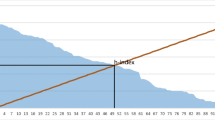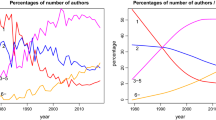Abstract
Keyword analysis has been an important research theme in bibliometrics. The deduction of new valuable bibliometric indicators/approaches through keyword analysis is important for prompting the further development of this subject area. In this study, the following three bibliometric indicators/approaches were thus derived. Indicator K was derived using the ratio between the average unique keyword number and average keyword frequency of a discipline for quantitatively describing the discipline’s development stages highlighted by scientific-philosopher Kuhn. Next, the correlation matrix analysis was used after k-core filtration to quantitatively expose the detailed correlations between topics for a large network. Thirdly, indicators I (node betweenness divided by node degree) and C (clustering coefficient) were collectively introduced to predict potential growth keywords. Diverse topical evolutions were categorized into a strategic diagram according to the tendencies of I and C. With sustainable development as a case study, we verified that the three new bibliometric indicators/approaches work well and can realize many new concepts beyond the scope of available indicators or approaches. In summary, the present paper makes a renewed effort to promote the development of bibliometrics. We hope our work could catalyze the further studies from the communities in the scientometric fields.















Similar content being viewed by others
References
Alvarezhamelin, J. I., Dall’Asta, L., Barrat, A., & Vespignani, A. (2005). K-core decomposition: a tool for the visualization of large scale networks. https://arxiv.org/abs/cs/0504107.
Badar, K., Hite, J. M., & Ashraf, N. (2015). Knowledge network centrality, formal rank and research performance: Evidence for curvilinear and interaction effects. Scientometrics, 105(3), 1553–1576.
Bailón-Moreno, R., Jurado-Alameda, E., Ruiz-Baños, R., & Courtial, J. P. (2005). Bibliometric laws: Empirical flaws of fit. Scientometrics, 63(2), 209–229.
Bastian, M., Heymann, S., & Jacomy, M. (2009). Gephi: An open source software for exploring and manipulating networks. In International AAAI conference on weblogs and social media; third international AAAI conference on weblogs and social media.
Blondel, V. D., Guillaume, J. L., Lambiotte, R., & Lefebvre, E. (2008). Fast unfolding of communities in large networks. Journal of Statistical Mechanics, 2008, P10008.
Borgatti, S. P., Mehra, A., Brass, D. J., & Labianca, G. (2009). Network analysis in the social sciences. Science, 323(5916), 892–895.
Buter, R. K., & Raan, A. F. J. V. (2013). Identification and analysis of the highly cited knowledge base of sustainability science. Sustainability Science, 8(2), 253–267.
Callon, M., Courtial, J. J. P., Turner, W. A., & Bauin, S. (1983). From translations to problematic networks—An introduction to co-word analysis. Social Science Information, 22(2), 191–235.
Chai, Y., & Wang, Y. (2006). A text feature selection method based on TFIDF. Electronic Technology & Information Science, 22(24), 24–26.
Chen, W., Liu, W., Geng, Y., Brown, M. T., Gao, C., & Wu, R. (2017). Recent progress on emergy research: A bibliometric analysis. Renewable and Sustainable Energy Reviews, 73, 1051–1060.
Daianu, M., Jahanshad, N., Nir, T. M., Toga, A. W., Jack, C. R., Jr., & Weiner, M. W. (2013). Breakdown of brain connectivity between normal aging and Alzheimer’s disease: A structural k-core network analysis. Brain connectivity, 3(4), 407–422.
Deville, S., & Stevenson, A. J. (2015). Mapping ceramics research and its evolution. Journal of the American Ceramic Society, 98(8), 2324–2332.
Ding, Y., Chowdhury, G. G., & Foo, S. (2001). Bibliometric cartography of information retrieval research by using co-word analysis. Information Processing and Management, 37(6), 817–842.
Everett, M. G., & Valente, T. W. (2016). Bridging, brokerage and betweenness. Social Networks, 44, 202–208.
Gao, W., & Cui, L. (2015). Scale-free and small-world properties in co-occurrence networks of major MeSH terms and all MeSH terms in MEDLINE. Chinese Journal of Medical Library and Information Science, 24(10), 65–71.
Girvan, M., & Newman, M. E. J. (2002). Community structure in social and biological networks. Proceedings of the National Academy of Sciences of the United States of America, 99(12), 7821–7826.
Gonzálezalcaide, G., Park, J., Huamaní, C., Belinchón, I., & Ramos, J. M. (2015). Evolution of cooperation patterns in psoriasis research: Co-authorship network analysis of papers in medline (1942–2013). PLoS ONE, 10(12), e0144837.
Huai, C., & Chai, L. (2016). A bibliometric analysis on the performance and underlying dynamic patterns of water security research. Scientometrics, 108(3), 1531–1551.
Kernighan, B. W., & Lin, S. (1970). An efficient heuristic procedure for partitioning graphs. Bell System Technical Journal, 49(2), 291–307.
Khasseh, A. A., Soheili, F., Moghaddam, H. S., & Chelak, A. M. (2017). Intellectual structure of knowledge in imetrics: A co-word analysis. Information Processing and Management, 53(3), 705–720.
Klein, F., Schodl, K., & Winckler, C. (2016). Mapping sustainability in pig farming research using keyword network analysis. Livestock Science, 196, 28–35.
Kuhn, T. H. (1962). The structure of scientific revolutions. Chicago: Chicago University Press.
Kumar, S., & Markscheffel, B. (2016). Bonded-communities in HantaVirus, research: A research collaboration network (RCN) analysis. Scientometrics, 109(1), 533–550.
Li, F., Li, M., Guan, P., Ma, S., & Cui, L. (2015). Mapping publication trends and identifying hot spots of research on internet health information seeking behavior: A quantitative and co-word biclustering analysis. Journal of Medical Internet Research, 17(3), e81.
Newman, M. E. J. (2003). Fast algorithm for detecting community structure in networks. Physical Review. E, Statistical, Nonlinear, and Soft Matter Physics, 69(6 Pt 2), 066133.
Newman, M. E. J., & Girvan, M. (2004). Finding and evaluating community structure in networks. Physical Review. E, Statistical, Nonlinear, and Soft Matter Physics, 69(22), 026113.
Phillips, K., Kohler, J. C., Pennefather, P., Thorsteinsdottir, H., & Wong, J. (2013). Canada’s Neglected tropical disease research network: Who’s in the core—Who’s on the periphery? PLoS Neglected Tropical Diseases, 7(12), e2568.
Quental, N., & Lourenço, J. M. (2012). References, authors, journals and scientific disciplines underlying the sustainable development literature: A citation analysis. Scientometrics, 90(2), 361–381.
Wang, J. (2009a). Domestic information services research concept network analysis based on complex network method. New Technology of Library & Information Service, 10, 56–61.
Wang, S. B. (2014). Empirical analysis of the research hotspot in the field of port logistics based on complex network. Computer Systems & Applications, 23(7), 246–251.
Wang, X. (2009b). Formation and evolution of science knowledge network(I): A new research method based on co-word network. Journal of the China Society for Scientific and Technical Information, 28(4), 599–605.
Wang, X. (2010). Formation and evolution of science knowledge network(II): Co-word network visualization and growth dynamics. Journal of the China Society for Scientific and Technical Information, 29(2), 314–322.
Wang, C., Lv, J., & Wu, X. (2013). Research focus and trends of scholarly network research. Journal of Intelligence, 32(10), 93–98.
Xin, J., & Cao, J. (2016). Detecting hotspots in literatures based on complex network and visualization. Computer Engineering and Applications, 52(12), 261–264.
Xu, Y. Y., & Wei, R. B. (2015). Analysis of the bibliometric laws based on the research topic——Take the open access as an example. Information Science, 33(11), 85–89.
Zamzami, N., & Schiffauerova, A. (2017). The impact of individual collaborative activities on knowledge creation and transmission. Scientometrics, 111(3), 1385–1413.
Zhang, H., & Cui, L. (2003). Study of bioinformatics through co-word analysis. Journal of the China Society for Scientific & Technical Information, 22(5), 613–617.
Zhang, Q. R., Li, Y., Liu, J. S., Chen, Y. D., & Chai, L. H. (2017). A dynamic co-word network-related approach on the evolution of china’s urbanization research. Scientometrics, 111(3), 1623–1642.
Zhang, W., Zhang, Q., Yu, B., & Zhao, L. (2015). Knowledge map of creativity research based on keywords network and co-word analysis, 1992–2011. Quality & Quantity, 49(3), 1023–1038.
Zhao, L., & Zhang, Q. (2012). Mapping knowledge domains of research frontier transferring in knowledge management field in china. Science of Science & Management of S & T, 33(1), 90–98.
Zhu, W., & Guan, J. (2013). A bibliometric study of service innovation research: Based on complex network analysis. Scientometrics, 94(3), 1195–1216.
Zhu, J., & Hua, W. (2017). Visualizing the knowledge domain of sustainable development research between 1987 and 2015: A bibliometric analysis. Scientometrics, 110(2), 893–914.
Zhu, D., Wang, D., Hassan, S. U., & Haddawy, P. (2013). Small-world phenomenon of keywords network based on complex network. Scientometrics, 97(2), 435–442.
Acknowledgements
We acknowledge the valuable guidelines on the revision and elaboration of the study from reviewers.
Author information
Authors and Affiliations
Corresponding author
Rights and permissions
About this article
Cite this article
Wang, M., Chai, L. Three new bibliometric indicators/approaches derived from keyword analysis. Scientometrics 116, 721–750 (2018). https://doi.org/10.1007/s11192-018-2768-9
Received:
Published:
Issue Date:
DOI: https://doi.org/10.1007/s11192-018-2768-9




